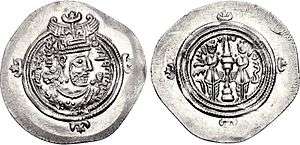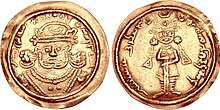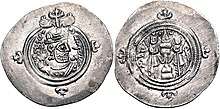Azarmidokht
Azarmidokht (Middle Persian: Āzarmīgdukht; New Persian: آزرمیدخت, Āzarmīdokht) was Sasanian queen (banbishn) of Iran from 630 to 631. She was the daughter of king (shah) Khosrow II (r. 590–628). She was the second Sasanian queen; her sister Boran ruled before and after her. Azarmidokht came to power in Iran after her cousin Shapur-i Shahrvaraz was deposed by the Parsig faction, led by Piruz Khosrow, who helped Azarmidokht ascend the throne. She was, however, the following year killed by Rostam Farrokhzad in retaliation for having his father killed. She was succeeded by Boran.
| Azarmidokht | |
|---|---|
| Queen of Queens of Iran | |
 Coin of Azarmidokht with the bust of her father Khosrow II to the left. | |
| Queen of the Sasanian Empire | |
| Reign | 630–631 |
| Predecessor | Shapur-i Shahrvaraz |
| Successor | Boran |
| Died | 631 Ctesiphon |
| House | House of Sasan |
| Father | Khosrow II |
| Religion | Zoroastrianism |
Name
"Azarmidokht" is the New Persian variant of her name used by scholars; her original name was Middle Persian, Āzarmīgdukht, meaning "daughter of the respected one", referring to her father Khosrow II (r. 590–628).[1]
Background and early life

Azarmidokht was the daughter of the last prominent shah of Iran, Khosrow II, who was overthrown and executed in 628 by his own son Kavad II, who proceeded to have all his brothers and half-brothers executed, including the heir Mardanshah.[2][3] This dealt a heavy blow to the empire, which it would never recover from. Azarmidokht and her sister Boran reportedly criticized and scolded Kavad II for his barbaric actions, which caused him to become remorseful.[4]
The fall of Khosrow II culminated in a civil war lasting four years, with the most powerful members of the nobility gaining full autonomy and starting to create their own government. The hostilities between the Persian (Parsig) and Parthian (Pahlav) noble-families were also resumed, which split up the wealth of the nation.[5] A few months later, a devastating plague swept through the western Sasanian provinces, killing half of its population including Kavad II.[5] He was succeeded by his eight-year-old son Ardashir III, who was killed two years later by the distinguished Iranian general Shahrbaraz, who was in turn murdered forty days later in a coup by leader of the Pahlav, Farrukh Hormizd, who helped Boran ascend the throne.[6] She was, however, the following year deposed and replaced with her cousin Shapur-i Shahrvaraz (who was also Shahrbaraz's son).[7] His rule proved even more brief than that of his predecessor−being deposed after less than a year by the Parsig faction led by Piruz Khosrow, who helped Azarmidokht ascend the throne.[7]
Reign

When Azarmidokht was made queen of Iran, she stated that the management of the country would be the same of her father, Khosrow II.[8] Farrukh Hormizd, in order to strengthen his authority and create a modus vivendi between the Pahlav and Parsig, asked Azarmidokht (who was a Parsig nominee) to marry him.[9] Azarmidokht, however, declined.[10] After having his proposal declined, Farrukh Hormizd "no longer shied away from the throne itself", declaring "Today I am the leader of the people and the pillar of the country of Iran."[10] He started minting coins in the same fashion as a monarch, notably in Istakhr in Pars and Nahavand in Media.[10] In order to deal with Farrukh Hormizd, Azarmidokht supposedly allied herself with Mihranid dynast Siyavakhsh, who was the grandson of Bahram Chobin, the famous military commander (spahbed) and briefly shah of Iran.[11] With Siyavakhsh's aid, Azarmidokht had Farrukh Hormizd killed.[12]
Farrukh Hormizd's son Rostam Farrokhzad, who was at that time stationed in the northeastern region of Khorasan, succeeded him as the leader of the Pahlav. In order to avenge his father, he led troops to Ctesiphon, the capital of the Sasanian Empire, "defeating every army of Azarmidokht that he met".[13] He then defeated Siyavakhsh's forces at Ctesiphon and captured the city.[13] Azarmidokht was shortly afterwards blinded and killed by Rostam, who restored Boran to the throne.[13][1] After this incident the center of power for the empire possibly drifted to the northeast, which was the homeland of the Pahlav, and was the area where Yazdegerd III, the last Sasanian king of kings, ultimately fled to seek aid against the Arab invasion of Iran.[14]
Coin mints and imperial ideology
During her brief reign, Azarmidokht had coins minted with the image of her father on the obverse, with the inscription khwarrah abzūd ("Increase in Glory") and the winged crown representing Verethragna, the name of the god of victory.[15] On the reverse there is the regular late Sasanian fire-altar with two custodians.[15] Her reason for putting her father was not so due to her gender, as it was not so significant compared to the rulers relation to the royal Sasanian family, and most essentially to Khosrow II, who was considered the last proper and legitimate king of kings of Iran.[15] Azarmidokht's reason for minting coins with the image of her father was thus to restore his image and that of the Sasanian house, an attempt which was first made by Azarmidokht's sister, Boran, who did not however use an image of their father, but instead resorted to pay tribute to him by referring to him in her inscriptions.[16] However, at the time when Azarmidokht ascended the throne, an inscription may have not been enough, thus resulting in the placement of Khosrow II's image on the obverse of the coins.[8]
Personality, appearance and accomplishments
Islamic sources describe Azarmidokht as an intelligent and very captivating woman.[1] According to the 10th-century historian Hamza al-Isfahani, the now lost book of Ketāb ṣowar molūk Banī Sāsān ("The Sasanian picture book") portrayed her as "seated, wearing a red embroidered gown and sky-blue studded trousers, grasping a battle-axe in her right hand and leaning on a sword held in her left hand."[1] The construction of a castle at Asadabad is attributed to her.[1] Her title was "the Just."[1]
References
- Gignoux 1987, p. 190.
- Kia 2016, p. 284.
- Howard-Johnston 2010.
- Al-Tabari 1985–2007, v. 5: p. 399.
- Shahbazi 2005.
- Pourshariati 2008, p. 185.
- Pourshariati 2008, p. 204.
- Daryaee 2014b, p. 80.
- Pourshariati 2008, pp. 205-206.
- Pourshariati 2008, p. 205.
- Pourshariati 2008, pp. 206, 210.
- Pourshariati 2008, pp. 206.
- Pourshariati 2008, p. 210.
- Daryaee 2014b, pp. 78-80.
- Daryaee 2014b, p. 79.
- Daryaee 2014b, pp. 79-80.
Sources
- Al-Tabari, Abu Ja'far Muhammad ibn Jarir (1985–2007). Ehsan Yar-Shater (ed.). The History of Al-Ṭabarī. 40 vols. Albany, NY: State University of New York Press.CS1 maint: ref=harv (link)
- Daryaee, Touraj (2014b). The Last Ruling Woman of Iranshahr: Queen Azarmigduxt. International Journal of the Society of Iranian Archaeology.CS1 maint: ref=harv (link)
- Gignoux, Ph. (1987). "Āzarmīgduxt". Encyclopaedia Iranica, Vol. III, Fasc. 2. p. 190.CS1 maint: ref=harv (link)
- Howard-Johnston, James (2010). "Ḵosrow II". Encyclopaedia Iranica, Online Edition.CS1 maint: ref=harv (link)
- Kia, Mehrdad (2016). The Persian Empire: A Historical Encyclopedia [2 volumes]: A Historical Encyclopedia. ABC-CLIO. ISBN 978-1610693912.CS1 maint: ref=harv (link)
- Pourshariati, Parvaneh (2008). Decline and Fall of the Sasanian Empire: The Sasanian-Parthian Confederacy and the Arab Conquest of Iran. London and New York: I.B. Tauris. ISBN 978-1-84511-645-3.CS1 maint: ref=harv (link)
- Shahbazi, A. Shapur (2005). "Sasanian dynasty". Encyclopaedia Iranica, Online Edition.CS1 maint: ref=harv (link)
Further reading
- Brosius, Maria. "WOMEN i. In Pre-Islamic Persia". Encyclopaedia Iranica, Vol. London et al.CS1 maint: ref=harv (link)
- Chaumont, Marie Louise (1989). "Bōrān". Encyclopaedia Iranica, Vol. IV, Fasc. 4. p. 366.CS1 maint: ref=harv (link)
- Daryaee, Touraj (2014a). Sasanian Persia: The Rise and Fall of an Empire. I.B.Tauris. pp. 1–240. ISBN 0857716662.CS1 maint: ref=harv (link)
- Daryaee, Touraj (2009). "Shapur II". Encyclopaedia Iranica.CS1 maint: ref=harv (link)
- Schmitt, Rüdiger (2005a). "Personal Names, Iranian iv. Sasanian Period". Encyclopaedia Iranica.CS1 maint: ref=harv (link)
- Schmitt, Rüdiger (2005b). "Personal Names, Iranian iv. Parthian Period". Encyclopaedia Iranica.CS1 maint: ref=harv (link)
- Sundermann, W. (1988). "Bānbišn". Encyclopaedia Iranica, Vol. III, Fasc. 7. London et al. pp. 678–679.CS1 maint: ref=harv (link)
Azarmidokht | ||
| Preceded by Shapur-i Shahrvaraz |
Queen of Queens of Iran 630 –631 |
Succeeded by Boran |